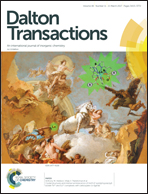Anion–π recognition between [M(CN)6]3− complexes and HAT(CN)6: structural matching and electronic charge density modification†
Abstract
Hexacyanidometalates (M = FeIII, CoIII) and multisite anion receptor HAT(CN)6 (1,4,5,8,9,11-hexaazatriphenylenehexacarbonitrile) recognize each other in acetonitrile solution and self-assemble into the novel molecular networks (PPh4)3[M(CN)6][HAT(CN)6] (M = Fe, 1; Co, 2) and (AsPh4)3[M(CN)6][HAT(CN)6]·2MeCN·H2O (M = Fe, 3; Co, 4). 1–4 contain the stacked columns {[M(CN)6]3−;[HAT(CN)6]}∞ separated by the organic cations. All of the M–C![[triple bond, length as m-dash]](https://www.rsc.org/images/entities/char_e002.gif) N vectors point collectively towards the centroids of pyrazine rings on neighboring HAT(CN)6 molecules, with Ncyanide⋯centroidpyrazine distances that are under 3 Å. The directional character and structural parameters of the new supramolecular synthons correspond to collective triple anion–π interactions between the CN− ligands of the metal complexes and the π-deficient areas of HAT(CN)6. Physicochemical characterisation (IR spectroscopy, UV-Vis spectroscopy, cyclic voltammetry) and dispersion-corrected DFT studies reveal the dominating charge-transfer (CT) and polarisation characters of the interactions. The electronic density flow occurs from the CN− ligands of [M(CN)6]3− to the HAT(CN)6 orbital systems and further, toward the peripheral –CN groups of HAT(CN)6. Solid-state DFT calculations determined the total interaction energy of HAT(CN)6 to be ca. −125 kcal mol−1, which gives ca. −15 kcal mol−1 per one CN−⋯HAT(CN)6 contact after subtraction of the interaction with organic cations. The UV-Vis electronic absorption measurements prove that the intermolecular interactions persist in solution and suggest a 1 : 1 composition of the anion–π {[M(CN)6]3−;[HAT(CN)6]} chromophore, with the formation constant Kadd = (5.8 ± 6) × 102 dm3 mol−1 and the molar absorption coefficient εadd = 180 ± 9 cm−1 dm3 mol−1 at 600 nm, as estimated from concentration-dependent studies.
N vectors point collectively towards the centroids of pyrazine rings on neighboring HAT(CN)6 molecules, with Ncyanide⋯centroidpyrazine distances that are under 3 Å. The directional character and structural parameters of the new supramolecular synthons correspond to collective triple anion–π interactions between the CN− ligands of the metal complexes and the π-deficient areas of HAT(CN)6. Physicochemical characterisation (IR spectroscopy, UV-Vis spectroscopy, cyclic voltammetry) and dispersion-corrected DFT studies reveal the dominating charge-transfer (CT) and polarisation characters of the interactions. The electronic density flow occurs from the CN− ligands of [M(CN)6]3− to the HAT(CN)6 orbital systems and further, toward the peripheral –CN groups of HAT(CN)6. Solid-state DFT calculations determined the total interaction energy of HAT(CN)6 to be ca. −125 kcal mol−1, which gives ca. −15 kcal mol−1 per one CN−⋯HAT(CN)6 contact after subtraction of the interaction with organic cations. The UV-Vis electronic absorption measurements prove that the intermolecular interactions persist in solution and suggest a 1 : 1 composition of the anion–π {[M(CN)6]3−;[HAT(CN)6]} chromophore, with the formation constant Kadd = (5.8 ± 6) × 102 dm3 mol−1 and the molar absorption coefficient εadd = 180 ± 9 cm−1 dm3 mol−1 at 600 nm, as estimated from concentration-dependent studies.
![Graphical abstract: Anion–π recognition between [M(CN)6]3− complexes and HAT(CN)6: structural matching and electronic charge density modification](/en/Image/Get?imageInfo.ImageType=GA&imageInfo.ImageIdentifier.ManuscriptID=C7DT00293A&imageInfo.ImageIdentifier.Year=2017)


 Please wait while we load your content...
Please wait while we load your content...